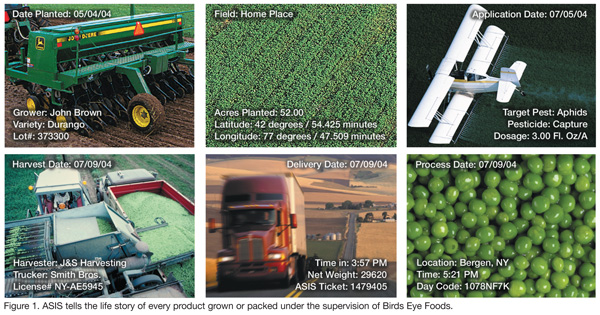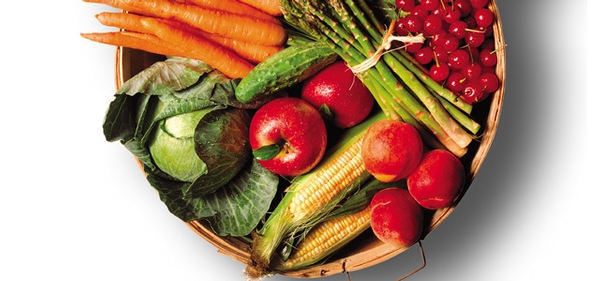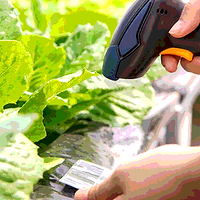Food safety issues dominate the news, and with good reason. The public is increasingly concerned about the health risks posed by potentially hazardous chemicals in foods, and each year millions of Americans become ill—and some die— from foodborne pathogens. When food safety is at stake, fast access to information is critically important to the food company and consumer alike.
That’s why a traceability system is such a vital industry tool: It creates a framework in which data collected from the continuous tracing and tracking of all food products and processes can be documented and linked to critical points throughout every part of the food manufacturing supply chain, from harvest through processing, to the retailer and finally, to the table. In the event of a recall or foodborne illness outbreak investigation, your company’s ability to quickly retrieve meaningful data is essential to identifying whether there is a problem in your production system, and if so, allows you to address the problem and take immediate corrective action.
An effective traceability system also helps to ensure that the food supply chain is not compromised from a food security standpoint and provides an excellent way to document regulatory compliance with bioterrorism rules. For example, under the new reporting and record-keeping rule issued in December by the U.S. Food and Drug Administration (FDA), companies are required to establish, maintain and provide access to records as directed by the U.S. Congress in the Public Health Security and Bioterrorism Preparedness and Response Act of 2002. The new regulation requires food companies to provide the FDA with ingredient source data, including immediate previous source (IPS) and immediate subsequent recipient (ISR) for every component used in the manufacturing process. In addition to U.S. food processing, transportation and distribution companies, the regulation impacts international organizations that import or export food or other biological products to the U.S. The rule also calls for food companies to keep records needed to determine exactly which ingredient lots go into shipments of food released to the marketplace.
At the same time, food companies are businesses. Particularly in today’s global market, corporations are keenly aware of the necessity of achieving production and supply chain efficiencies while maintaining high quality products that customers and consumers want to buy. Developing and implementing an automated traceability information system can help a company achieve all of these objectives, but first it is important that each company defines traceability according to its specific operational structure and goals, as well as fully examines why it is important to implement such a program. These elements are the foundation for an efficient and effective traceability system that allows you and your customers rapid access to crucial—and accurate—food safety and security information.
Like all food companies, Birds Eye Food’s reputation rides on the safety and quality of our products. That’s why Birds Eye has invested several million dollars and more than six years in the development of a tool to better manage procurement and flow of raw product into our processing facilities—the Agricultural Services Information System (ASIS). ASIS is a proprietary agricultural database information system built from the ground up specifically for our business. With its ability to store detailed crop history, ASIS provides traceability from field to processing plant for those crops grown under Birds Eye’s supervision. It is an integrated, web-based system that offers total traceability for every step of the production chain, from seed to processing facility, to assure consumer safety. Information derived from and stored in ASIS, coupled with information from Birds Eye’s processing plant traceability programs, makes the life story of every package immediately available.
While ASIS focuses on the traceability of the raw agricultural product side of the food supply chain—i.e., tracking products from seed to scale at the processing plant door—many of the successful elements used in its design can be generally applied to the development of processing or retail traceback programs. In detailing the Birds Eye Foods experience in developing and implementing ASIS, some of these key concepts are highlighted to illustrate how a well-planned traceability system strengthens your food operation’s food safety, security and product quality standards.
Tracing the Origins of ASIS
Since the events of Sept. 11, 2001, the impetus to develop improved traceability systems in this country has spurred efforts by the food industry to institute traceability systems for biosecurity purposes. While 9/11 had many scrambling to develop these systems, the Birds Eye ASIS program had been up and running for more than a year by that time.
 The catalyst for the development of ASIS is simply explained by a second acronym: Y2K. In 1997, three years prior to the predicted doomsday failure of computer systems worldwide, Agrilink Foods, Inc., a wholly owned company of Pro-Fac Cooperative, Inc. (and renamed Birds Eye Foods in 2003), realized that addressing the potentially devastating consequences of Y2K to our mainframe system was a task better completed earlier than later and that the existing mainframe system would soon be outdated. Given the company’s 40 years in the agriculture business, where change doesn’t happen quickly, the decision was made to take a more evolutionary, rather than revolutionary, approach to redesigning the information platform with a view toward developing a system with broad capabilities that would last long past Y2K. In doing so, we looked to Europe, where an exciting new supply chain management concept known as “traceability” was taking hold at the time in response to consumers’ calls for more information about where their food was grown and processed.
The catalyst for the development of ASIS is simply explained by a second acronym: Y2K. In 1997, three years prior to the predicted doomsday failure of computer systems worldwide, Agrilink Foods, Inc., a wholly owned company of Pro-Fac Cooperative, Inc. (and renamed Birds Eye Foods in 2003), realized that addressing the potentially devastating consequences of Y2K to our mainframe system was a task better completed earlier than later and that the existing mainframe system would soon be outdated. Given the company’s 40 years in the agriculture business, where change doesn’t happen quickly, the decision was made to take a more evolutionary, rather than revolutionary, approach to redesigning the information platform with a view toward developing a system with broad capabilities that would last long past Y2K. In doing so, we looked to Europe, where an exciting new supply chain management concept known as “traceability” was taking hold at the time in response to consumers’ calls for more information about where their food was grown and processed.
The company’s first step was to define traceability to suit a real-world application; in other words, to take the abstract concept and transform it into a highly functional information tool. Since the International Organization for Standardiza-tion’s (ISO) definition of traceability does not delineate a standard unit size required to set a framework for the boundaries of a traceability system, we began by determining what boundaries made the most sense with respect to Birds Eye’s specific procurement and raw product flow cycles and systems. Several factors were considered, including:
• How Much Information? Deciding the parameters for the breadth and depth of the traceability system is the first consideration. Setting these boundaries is imperative so that an adequate amount of usable information is obtained for traceability purposes and further, so that the information collected is meaningful. For example, if we know where the seed came from, do we also need to know, in our system, where the seed of the seed of the seed came from? Further, do we need to know, in our system, what fertilizer was put on the piece of land that grew the seed of the seed of the seed? During the ASIS design phase, we determined that the answer to these questions is no. Not only would credible data be very difficult to obtain from that far back in the historical record, such an exercise would generate too much information, much of which would not necessarily provide usable data points, bogging down the system.
Ultimately, we focused on our supply management chain in setting the boundaries for ASIS. Knowing that the cycle begins when Birds Eye buys seed for our growers and and ends when Birds Eye receives, warehouses and stores the raw product, we decided that the framework in which our traceability system would give us the maximum amount of usable information was with the cycle of these parameters. The traceability cycle ends with the final transaction between grower and Birds Eye, where the raw product passes ownership and payment is generated. We decided to tie all of our control points to where dollars passed hands. If a grower, or any other business in ASIS, is to be paid, the information gathered within the traceability boundaries has to exist within ASIS.
• How Much Detail? Once the boundaries of the system was set, the level of detail needed to achieve the company’s information objectives was our next consideration. The traceability system is a tool, and it is only as good as the information that is put into it. Not only do you have to be careful about the quantity of information introduced into the system, but you have to be attentive to the quality of that information. By identifying traceability checkpoints as any point at which a business is paid for goods or services, these can be considered control points. Furthermore, if the information is not in the system, the load cannot be delivered. In looking at each of these points, how much detail is required in terms of both the quantity and quality of the information becomes clear.
For example, the beauty of ASIS is that it won’t allow a delivery at a delivery point unless all of the required information from the point the initial contract with a grower has been entered prior to arriving at that delivery, or checkpoint. If a grower is not a valid contracted supplier in the system, we can’t pay for or receive product. If a grower doesn’t have a field with a planting assigned to it, he can’t make a delivery. If that planting doesn’t have a spray record associated with it, it can’t be delivered. If the trucker who is transporting product does not have his name or a contract in the system, we can’t accept his load. In this way, the amount of information entered into the system is controlled.
Also, by associating these checkpoints with the constant of money (i.e., payment), the quality of information entered into the system is significantly raised. In addition to Birds Eye’s internal system checks, grower interaction also ensures quality data.
• Standardization. Part of any food safety program is the ability to trace back throughout the whole system. This means that to achieve traceability on a company-wide basis, all information must be fed into a common Enterprise Resource Planning (ERP) program. In classic systems, each and every production location has its own protocol, particularly in companies as large as Bird’s Eye. Because of that, there are different programs that are created and administered at each location but that provide the same information. When these various data points are entered into a common platform system, the information can be rapidly accessed, thus providing us the ability to quickly determine whether there is a problem or not, and if so, where that problem is occurring so it can be immediately addressed and corrected.
The common platform also allows Birds Eye to link ASIS information, which traces the seed to the scale at the production plant, to other ERP systems, such as those in the processing plants, to get an even broader perspective on traceability. For example, ASIS information links can be linked to the day code on a package after it runs through the plant, and those links are built into the company’s other ERP systems.
The result of Birds Eye’s efforts, of course, is ASIS, the integrated, real-time, web-based system that provides our Agricultural Services Department a single platform to rapidly communicate with stakeholders at the grower, processing plant and corporate level across all growing areas. ASIS allows Birds Eye to link each package to the harvester, as well as to the date and time of harvest. We link each package to the pesticide applicator, the chemical used and rate of application, as well as the specific pest targeted. We link each package to the grower, the field and lot, as well as to the date of planting, the origin of the seed and its variety and treatment. These basic informational links offer several benefits:
• In the event of a recall, we can quickly isolate the affected product.
• If there’s a concern about pesticide use, we have fast access to complete data. And the system has built-in timing schedules that track proper intervals between spray and harvest.
• Historical data can tell which crops were grown on a particular field and lot in the past year, what pesticides were used and why.
• ASIS also enables advanced schedule management that helps Birds Eye maintain product quality and on-time deliveries.
In conjunction with other Birds Eye Foods information systems, ASIS provides practical information in addition to the above, including linking individual deliveries to third-party service providers, such as harvesters, receiving stations and truckers, and tracking sales of raw product to third parties and product transfers between sites.
The capability of rapid traceability, backward and forward, throughout the raw product supply chain is now a key component to Birds Eye’s food safety program. ASIS is tested on a regular basis as an element of our recall program and mock recall exercises.
Another interesting feature of ASIS is that it becomes three-dimensional in the case of a multiple contract in which different payment streams are involved. For example, the Pro-Fac Cooperative, which has a significant ownership in Birds Eye Foods, has more than 500 grower-members located in the prime growing regions of 11 states. Pro-Fac, as an organization, has a supply agreement with Birds Eye Foods, which means that when a purchase is made through Pro-Fac those deliveries are connected with Pro-Fac in ASIS. With a Pro-Fac delivery, the grower delivers directly to Birds Eye. That information has to be recorded and kept separately because that same grower tomorrow might deliver under a direct contract to Birds Eye. Birds Eye also has contracts to supply processing vegetables to other processing plants in New York. Since Pro-Fac has an agreement with Birds Eye and Birds Eye has an agreement with the other processors, the grower, who works with Pro-Fac, delivers directly to those processors at their production facilities. The accounting of that transaction requires that the delivery goes back to Birds Eye, which goes back to Pro-Fac, and finally, to the grower. Since a buyer can be a seller on the same delivery ticket, this accounting provides the added informational dimension needed to achieve accurate traceability.
Please Pass the Peas—Through the System
Essentially, the ASIS program is designed based on the grower’s point of view, with each crop year standing on its own, allowing data entry based on the natural order of agricultural production, from planning and contracting through delivery and payment for the crop (Figure 1). A crop cycle starts when a contract is agreed upon and ends with a final payment to the grower. During that contract term, specific information about each critical point, such as seed purchase, planting, pesticide application, and harvest-time sampling and harvest yield records, are stored in ASIS for data mining as needed. When the grower delivers the crop, records involving critical points such as transport, raw product grading and storage are entered into ASIS. When all of these records have been entered into the system, the delivery is priced and validated. After a second validation, payment is calculated and generated.
The traceback capability that ASIS affords can be well understood by following, from left to right, the route of a crop of peas shown in the Figure 1 image strip. Essentially, this shows some of the checkpoint highlights within a crop cycle. The real-time traceback process begins with the final product, a package of peas, and with the question, “Where did it come from?” From the day code on the frozen package, we will find the date, time of day and location where the contents of the package were processed. This information is linked to the delivery ticket numbers residing in ASIS, which provides an overview of the status of the transaction. There is one ticket per load of product. This ticket number will give you access to the actual delivery ticket information in ASIS, which is presented backwards, from the most recent transaction, say the final payment, back to initial agreement with the grower and seed purchase at the beginning of the crop cycle.
The delivery ticket includes details such as what contract the load was delivered under, the variety of peas, what field and planting it came from, net weight, the time and date the load of peas arrived, the raw product grading scores, who delivered the product, the license number of the truck, the name of the truck driver, who graded and weighed the load, whether it has been posted for payment, and so on. It also includes special delivery attributes that may apply to a particular commodity, such as the temperature of the load or the length of time it sat outside of the plant when tracing back certain temperature-sensitive products. The physical ticket number also will relate this load back to other records or company information systems, such a scale ticket or an invoice, since there is only one number assigned to the transaction.
Continuing the traceback process of the load of peas, we know that this delivery had to come from somewhere, and in ASIS, those locations are divided into fields and plantings. A planting exists inside of a field and may move around within the boundaries of that field. A field is defined as an area of ground bounded by a fixed object such as a highway that does not change from year to year. We use one GPS point per field and one GPS point per planting to exactly identify locations for traceback purposes. Within the next few years, the U.S. Department of Agriculture (USDA) will have completed its mapping of U.S. farmland as part of a digitization process and one GPS point will give enough information to tell us the exact location of each planting and field, as well as link each point to the history of that plot collected by USDA. ASIS will provide specific information on when and where the crop is planted, the latter being very important since we want to know what was previously planted there and what is going to be planted the next year.
Now that we know the location of this pea field and the planting within, we can view the pesticide records that are linked to that planting. The database inside of ASIS won’t allow delivery if there is a pesticide use violation, such as the grower hasn’t waited an adequate number of days. The system will allow this information to be entered as a record where we are able to see these types of problems and address them.
Ultimately, we trace the peas to their beginnings. ASIS provides information including the history of those plantings, when the peas were planted, and what seed was used (lot, variety and treatment). There is a link tracing that seed to the delivery receipt under which it was delivered. This is important because if there is a problem with a specific lot of seed—for example, in one field the peas grew but in another they did not—we want to know what happened. During the traceback investigation, the information in ASIS might show that a part of the lot of seed was transported on a truck that got too hot and now we can trace the problem back to the trucker who delivered it.
Birds Eye’s 100,000-Ft. View
While ASIS is a workhorse for traceability, the integrated database system is also flexible enough that Birds Eye is planning to utilize the system for the record-keeping associated with our sustainable agriculture initiative. Today’s consumers are wanting more information about the foods they eat and how they are grown, processed and handled. In the near future, they will want assurances that the food they are purchasing is being produced in a manner that minimizes negative environmental impact, and promotes sustainability. This trend is certainly global in nature, in that the consumer may not live in Iowa or Mexico, but he or she cares about what happens in those areas because his or her food is grown there. Because ASIS contains all of the necessary information within its database, Birds Eye will be able to mine data that pertains to these types of sustainability concerns.
Birds Eye Foods takes great pride in everything that goes into our products. With ASIS, we add an essential ingredient—the peace of mind made possible by a comprehensive information system for food product safety. Knowing the life story of food products from field to marketplace is key to ensuring food safety and security and assuring delivery of the highest quality products. As more and more food companies develop traceability systems, the industry will find that the benefits gained from this essential tool will provide increased opportunities to improve supply chain management.
Rhett Smith is the Director of ASIS Implementation for Rochester, NY-based Birds Eye Foods, Inc., the nation’s leader in frozen vegetables and a major processor of other food products (www.birdseyefoods.com). Since 2000, Smith has been part of the team that designed, developed and deployed ASIS, Birds Eye’s Agricultural Services Information System. Currently, he is a member of the team designing and developing Birds Eye’s Sustainable Agriculture initiative. Smith has more than 20 years of experience in agricultural raw product procurement in the U.S., Mexico and the Dominican Republic.




